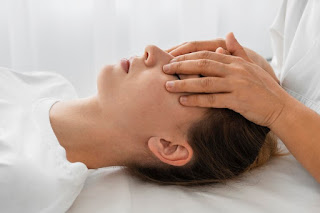Finding Calm in the Chaos: A 9-Minute Acupressure Guide for Stress Relief
In our fast-paced world, stress has become a constant companion. It creeps into our daily lives, affecting our physical and emotional well-being. Fortunately, there are accessible and effective methods to combat stress, and acupressure is a great option to consider.
Acupressure, a traditional Chinese practice, applies finger pressure to specific points on the body to alleviate stress and promote relaxation. It shares principles with acupuncture but uses finger pressure instead of needles. These pressure points are believed to be connected to energy pathways. By applying pressure, you can unblock and balance the flow of energy, often referred to as "qi" or "chi."
Benefits of Acupressure for Stress Relief:
Instant Relaxation: Acupressure can provide immediate relief from stress and tension, promoting a sense of calm.
Reduced Muscle Tension: It helps release tight muscles, which often hold the physical manifestations of stress.
Improved Sleep: Regular acupressure sessions can lead to better sleep quality, ensuring you wake up feeling refreshed and ready to take on the day.
Emotional Balance: By balancing the body's energy, acupressure can help stabilize your emotions, making it easier to manage stress.
Enhanced Focus and Clarity: Acupressure can clear mental fog, allowing for increased focus and mental clarity.
The 9-Minute Acupressure Exercise for Stress Relief
This simple exercise targets key pressure points for stress relief. You can perform it anywhere, at home or work, and it only takes 9 minutes!
1. Find Your Quiet Space:
Begin by finding a quiet and comfortable space where you won't be disturbed for 9 minutes. Sit or lie down, whichever position allows you to relax the most.
2. Deep Breathing:
Take a moment to focus on your breath. Inhale deeply through your nose for a count of four, and then exhale slowly through your mouth for another count of four. Repeat this deep-breathing exercise three times to center yourself.
3. Locate the Pressure Points:
The Third Eye Point: Place your index and middle fingers between your eyebrows, at the bridge of your nose. Gently apply pressure in a circular motion for 2 minutes. This point is known to relieve stress, anxiety, and promote relaxation.
The Heavenly Pillar: Move your fingers to the base of your skull, just below the indentation where your skull meets your neck. Apply gentle pressure for 2 minutes while taking slow, deep breaths. This point can help alleviate stress and tension in the neck and shoulders.
The Sea of Tranquility: Slide your fingers down to the center of your breastbone, right above your heart. Apply pressure here for 2 minutes while continuing to breathe deeply. This point can calm the mind and reduce anxiety.
The Inner Gate: Find the crease in your wrist on the palm side, approximately three finger-widths down from your wrist crease. Apply gentle pressure for 2 minutes to reduce stress, anxiety, and promote relaxation.
4. Conclude the Exercise:
Finish the exercise by returning to deep breathing for one minute, allowing yourself to fully relax and release any remaining tension.
Tips for Effective Acupressure:
Apply steady and gentle pressure to the points without causing discomfort.
Breathe deeply and slowly while focusing on the pressure points to enhance the relaxation effect.
If you have specific stress triggers, visualize releasing them as you apply pressure to each point.
Make acupressure a regular practice to maximize its benefits for stress management.
Additional Stress-Relief Techniques:
While acupressure is a powerful tool, combining it with other stress management techniques can further enhance its effectiveness. Consider incorporating some of these practices into your routine:
Mindfulness Meditation: Regular mindfulness meditation helps you stay present, manage stress, and build resilience.
Exercise: Physical activity releases endorphins, natural mood lifters and stress reducers.
Aromatherapy: Certain essential oils, like lavender and chamomile, can promote relaxation and reduce stress when diffused or applied topically.
Progressive Muscle Relaxation: This technique involves tensing and then relaxing different muscle groups to release physical tension.
Yoga: Yoga combines physical postures, breathing exercises, and meditation to reduce stress and enhance overall well-being.
Healthy Lifestyle: A balanced diet, regular sleep, and limiting caffeine and alcohol can help reduce stress.
Conclusion:
Stress is an inevitable part of life, but how you manage it makes a big difference. Acupressure is a simple yet effective technique that can provide immediate stress relief and promote relaxation.




Comments
Post a Comment